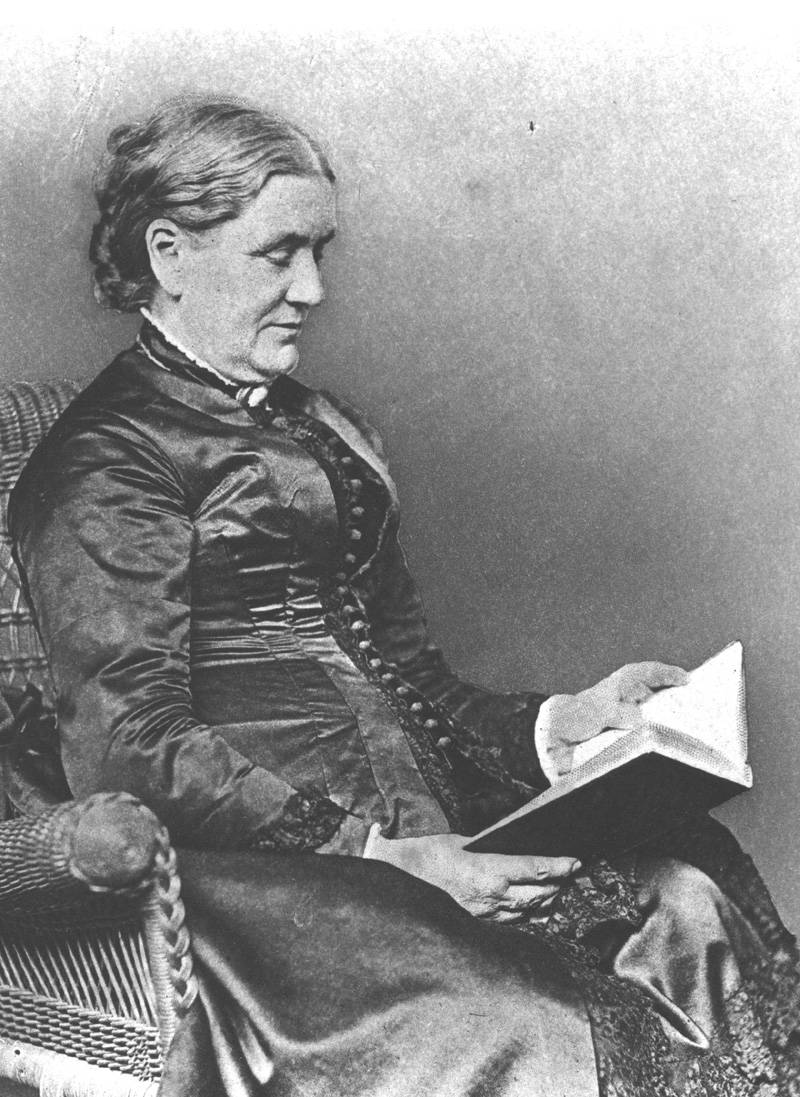Lucy Larcom's Bethel
Title
Creator
Source
Publisher
Date
Format
Identifier
Text Record
Subjects
People
Collection
Full Text
Lucy Larcom's Bethel
by Stanley R. Howe

Lucy Larcom (1824-1893)
Observing nature was a major focus of the life of Lucy Larcom (1824-1893), who spent much time in the White Mountain region and especially in the western Maine town of Bethel. That town, with its spectacular vistas and easy access to mountain views and river valleys, was a special place for this woman, who in the 19th century became one of the best known poets in New England.
According to Shirley Marchelonis, in her book, The Worlds of Lucy Larcom (Athens, Georgia: University of Georgia, 1989), Larcom came to know Bethel in 1876 when she decided to venture into the mountains. Miss Larcom came from Beverly by steamboat as far as Portland, Maine, then by rail to the Bethel station, and from there by carriage to John Russell’s Riverside Cottage, which then stood on the site of the present home of Randy and Cathy Autry on Intervale Road. In back of the house, a hill rose steeply and on the crest was a little glen shaded by evergreens. Here was a latticed summer house, which came to be known as “Miss Larcom’s Retreat,” where she sat, read and wrote her poetry. From this level, she enjoyed a splendid view of the Androscoggin River and the majestic intervale elms. Mount Moriah in Shelburne and several peaks of the Presidentials, including Madison, Adams and Washington, were also part of this visual “feast.” Shirley Marchelonis has observed that Bethel came to be the ideal place for Larcom. As a mountain town, it appeared “delightful” in every way. The poet was apparently captivated by the Androscoggin River and its surroundings, the mountains, and most particularly the outstanding sunsets, which seemed to call her back each year. Not even pleas from her friends in New Hampshire could get her to move from her Bethel resting place.
Born in Beverly, Massachusetts, in 1824, Lucy Larcom was a sensitive and precocious child, early in life developing a fascination with poetry and religion. After her father’s death due to the family’s straited circumstances, she, her mother and siblings moved to Lowell, where she began working in the textile mills of that city. It was here that she began writing for several literary magazines.
In 1846, Larcom journeyed to Looking Glass, Illinois, to begin a teaching career, where for several years she learned “what education really is.” This experience led to more teaching in Monticello, Illinois, and later at Wheaton Seminary (now Wheaton College) in Norton, Massachusetts. Her enthusiasm for all things literary and interest in history plus her genuine fondness for her students extended her influence beyond the classroom. She published her first book of poetry in 1869 and by 1884 had become a very popular poet. Her poetry was often uneven in quality, simple and unadorned with flexible rhythms and easy rhymes. It can also be characterized by a strong moral tone and numerous spiritual visions which make it appear to today’s readers as quaint and lifeless.
The same is not true of her autobiography, A New England Girlhood, Outlined from Memory, which was published four years before her death in 1893. This work contains detailed descriptions of life in New England mill villages, focusing particularly on the world of a Lowell, Massachusetts, factory girl. Larcom’s insights into this 19th century work experience make this book a significant contribution to American social and labor history. It also deserves praise for its literary quality. Larcom’s experience as a mill worker left her with a lifelong aversion to loud noises. It also created in her, according to biographer Marchalonis, a continuous struggle between “stillness and stir,” an alternating penchant for solitude followed by a period of intense activity. Moreover, her romantic interest in Dr. Frank Spaulding was complicated and only resolved by her realization that she would be better off living her life alone among good friends such as John Greenleaf Whittier and James and Annie Fields.
Throughout her later adult life, Bethel always remained a favored place where, as she wrote Whittier in 1884, she could “read . . . proof and escape hay fever.” It is clear from reading some of her Bethel poems that she was familiar with many of the natural landmarks of the town, as is indicated in one poem included in William B. Lapham’s 1891 History of Bethel. In what is perhaps her best Bethel poem, “On the Ledge,” one finds references to “Paradise,” the “mountainous West” (the Presidential Range), and, finally, the “beautiful meadows and mountains of Maine.” This devotion to her Bethel setting knew few limits, and the restorative qualities of the place served her well for the last twenty years of her time on earth. She always departed Bethel with regret, but full of new energy to face the rigors and demands of the literary life.
